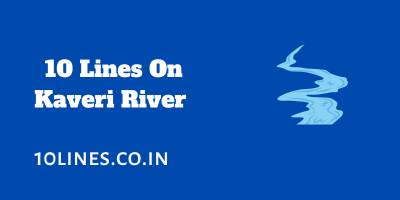10 Lines On Kaveri River Are you looking for a 10-line essay on the Kaveri River? This article contains three different 10-line essays Kaveri River for various age groups. Three essays are provided below for children, school students, and college students. To learn more about the Kaveri River, read the entire article.

10 Lines On Kaveri River For Children And Students
We have provided a lot of information about the Kaveri River, including its origin, length, tributary rivers, importance in local culture, and soon.
Kaveri also known as Cauvery is the fourth largest river in south India majorly flows through the states of Karnataka, Tamilnadu and Kerala. It is one of the holy rivers in India, considered among 7 sacred rivers from India worshipped as Kaveramma among their devotees.
It is best to read the entire article to learn much about the holy river Kaveri.
Set 1] 10 Lines On Kaveri River For Children:
1] The Kaveri also known as Cauvery is South India’s fourth-largest river.
2] The river is the ninth-longest in India with a length of 805 kilometres.
3] The river is also referred to as ‘Cauvery’ and ‘Ponni’ in Tamil.
4] The Kaveri’s basin area covers around 81,155 square kilometres.
5] At Poompuhar in Tamil Nadu, the Kaveri River empties into the Bay of Bengal.
6] Kaveri, the largest river in Tamil Nadu, divides the state into north and south regions.
7] Kaveri is a sacred river in southern India that flows mostly through the states of Karnataka and Tamil Nadu.
8] Kaveri is a sign of motherhood, and the nurturer.
9] The Kaveri Pushkaram (Kumbh mela) festival is held once every 12 years at Mayiladuthurai, Tamil Nadu.
10] Tiruchirappalli, Erode, and Thanjavur are some of the cities on the banks of the Kaveri River.
Set 2] 10 Lines On Kaveri River For School Students:
1] The Kaveri River traverses the Indian states of Tamil Nadu, Kerala, Karnataka, and Puducherry.
2] The Cauvery basin covers an area of 81155 square kilometres or roughly 2.7% of the country’s total geographical area.
3] The river Kaveri is known as ‘Ponni’ in Tamil.
4] The Kaveri River empties into the Bay of Bengal near Poompuhar, also known as Kaveripoompattinam in Tamil Nadu.
5] Around 29 major tributaries, including Harangi, Tirtha, Hemavati, Noyyal, Kabini, Bhavani, Lakshmana, and, flow into the river.
6] Water from the Kaveri River is largely used for irrigation, drinking, and electricity generation.
7] The historical and culturally significant town of Srirangapatna is situated on the Kaveri River’s bank.
8] The Kallanai dam, one of the oldest in the world, was constructed on the Cauvery River over 2000 years ago.
9] The Kaveri basin’s primary soil types are black soils, red soils, laterites, alluvial soils, and forest soils.
10] The river divides into a huge number of distributaries before draining into the Bay of Bengal, creating a broad delta known as the “garden of southern India”.
Set 3] 10 Lines On Kaveri River For College Students:
1] The Kaveri is regarded as one of India’s seven holy rivers and is a sacred river to the people of South India.
2] The Cauvery River originates in Karnataka near Talakaveri on the Brahmagiri range in the Western Ghats at an elevation of approximately 1341 metres.
3] The Kaveri basin encompasses 81,155 square kilometres (sq.km) across the states of Karnataka, Tamil Nadu, and Kerala, as well as the Union Territory of Puducherry.
4] The river travels about 475 kilometres in a south-easterly direction to meet the Bay of Bengal.
5] As early as 1902, Asia’s first hydroelectric dam was built across the Kaveri at Shivanasamudra.
6] The delta known as the Garden of Southern India is the result of the Cauvery River being split up into numerous distributaries.
7] The Kaveri River begins and ends only in Indian states.
8] According to Hindu mythology, the river was produced when Ganesha in the form of a crow came and tipped down Sage Agastya’s pot, which became the river, Kaveri.
9] Because of the widespread usage of water for agriculture, the river serves as a lifeline for irrigation in Karnataka and Tamil Nadu.
10] The water of the Kaveri River is contaminated by a wide range of pollutants, including pharmaceutical substances, municipal garbage, plastics, and drainages.
Friends, thank you for reading the river Kaveri article. We hope you found the information above useful and that you enjoyed reading it. We made an effort to present this information about river Kaveri in a simple and easy-to-remember format. Let us know in the comments section how this article helped you.